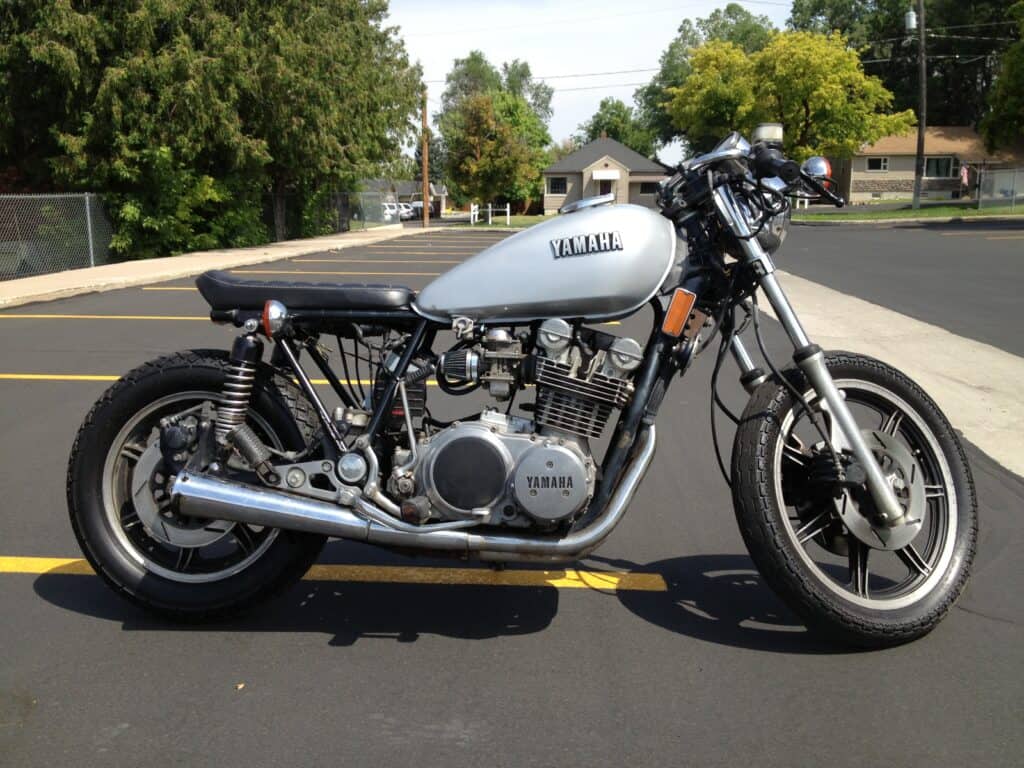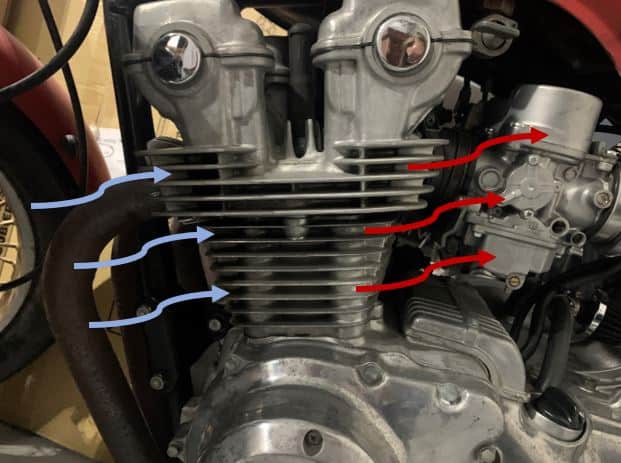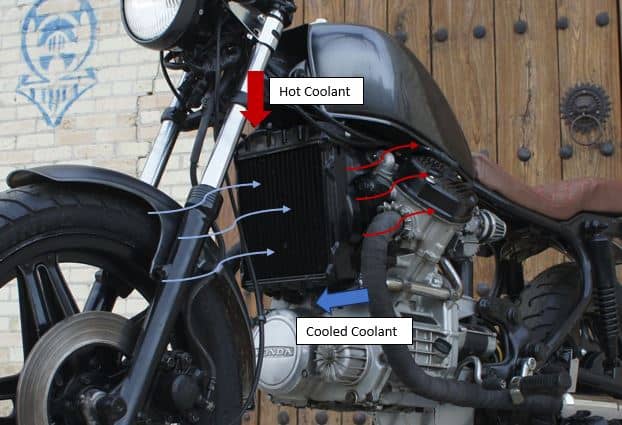
Any machine that has an internal combustion process will require some sort of cooling system to keep the metal from overheating. Motorcycles are no exception to this rule and the cooling system on them is very important.
Knowing how the cooling system works can prevent a rider from overheating their engine which can also prevent costly fixes. If you’re going to own a motorcycle, make this one of your priorities to understand before you start riding on the road.
So, how does a motorcycle cooling system work? A motorcycle cooling system works in two different ways: first is air cooling in which natural wind passes through fins that are on the outside of the cylinder and cylinder heads. The second is through water cooling where coolant passes through thin plates on a radiator that is cooled through natural wind and recirculated into the engine.
The cooling system on a motorcycle is a pretty simple process but can have terrible consequences when it doesn’t work right. I’ve owned motorcycles with both types of cooling systems. Having a degree in mechanical engineering, I’ll geek out and explain in simple terms how the cooling system works on a motorcycle and inform you of other information you’ll need to know as a rider.
How An Air Cooling System Works
Air cooling is the most common way for a motorcycle to cool itself down. Most motorcycles will have this. It’s efficient in a sense that it requires less parts to complete the cooling down of an engine. You’ll notice how a lot of motorcycle will have ridges, or fins, on the engine. These aren’t simply for looks, they actually serve a vital purpose in the functionality of the motorcycle (though they do look pretty cool!).
The combustion process inside an engine is extremely hot and it needs to be in order for the engine to move those pistons up and down to make the motorcycle move. But the engine can’t get too hot because that will mean the structure of the metal components will begin to change and in turn can ruin the engine entirely.
You may have heard the term “a seized engine.” This means the pistons inside have somehow fused to the cylinder walls; this is usually because those parts got way to hot and essentially melted together. The engine is basically totaled when this happens. It’s possible to get it fixed but it’s probably more economic to simply get a new engine entirely.

This is where those fins come into play. Most of the parts on a motorcycle are exposed anyway, so placing fins on the cylinder and cylinder head is a perfect way to cool down the engine. These fins are generally made from aluminum because it’s light weight and has a higher heat transfer efficiency.
While riding a motorcycle down the road, wind will naturally pass through these fins and will essentially cool down the engine. The engine would not be able to cool itself down as efficiently without the fins; the structure of the fins can catch air much better than the engine block itself.
How A Water Cooling System Works
The way a water cooling system works on a motorcycle has the same principle as air cooling but is performed differently. You’ll notice that a water cooled motorcycle engine looks a little different than others. This is because these types of bikes usually don’t have fins, instead they have what is called a radiator likely placed at the front of the engine block.
This is a more complex system but can withstand more extreme temperatures. Instead of fins on the outside, there are trails called water jackets that are inside the engine and around the cylinders. Attached to these trails is a radiator as well as a reservoir.

A pump (known as the water pump) circulates and pushes a water/antifreeze solution from the water jackets inside the engine to the radiator then back into the engine. This coolant is passed through small plates during radiator circulation which essentially cools it down due to the wind passing through it. Then the cooled down substance is then recirculated throughout the engine to cool it down.
The thermostat plays a vital role because it senses the temperature of the engine and regulates how much coolant passes through the engine as needed. An extra fan is placed by the radiator and is turned on as a backup in case the coolant isn’t cooling down the engine fast enough. A reservoir also plays a vital role as extra coolant is placed there through pressure in the case the radiator needs it.
Though this method is commonly referred to as “water cooled,” it’s not just water that circulates throughout the engine. A 50/50 mixture of antifreeze and water is needed for optimal temperature control; the antifreeze has a higher tolerance for both freezing and extremely hot temperatures so you don’t have to worry much about riding your motorcycle in either condition. Plain water in a system like this gives it less tolerance and can overheat your engine.
Which One Is Better?
Let’s discuss air cooling. One of the biggest advantages of a system like this is it’s simplicity. Really the only parts that go along with this is the fins and that’s basically it. That means no coolant leaks and there’s less parts to maintain which means it’s cheaper, too.
Because of the simplicity of this system, your engine will warm up much faster when you’re trying to go for a ride. You don’t have to wait for the coolant to circulate and do it’s thing before reaching optimal operating temperature.
The biggest disadvantage of having an air cooling system is that it’s less efficient compared to a water cooling system. This, in turn, means you’ll have a higher risk of overheating the engine which could mean costly repairs later on. Though the system is much less complex, the fins on the engine can be a complicated fix if enough of them are broken. A chip here or there isn’t much of a worry, but a hard impact or drop with several fins broken could mean you need a new cylinder head or cylinder covers altogether.
How about the advantages of water cooling? Water cooling is essentially much more efficient with how it regulates temperature of a motorcycle engine. The regular heat transfer it’s constantly performing can assure a rider that their motorcycle is much less likely to overheat, especially if they’re riding a sports bike or using it for commuting.
Unlike air cooled, water cooled engines do have a lot of parts that you’ll have to take care of and maintain. This system is obviously much more complex than an air cooled system, so there could be several culprits as to why an engine overheats if you find yourself on the side of the road with one.
You’ll also need to stay on top of coolant levels; forgetting to top it off or letting it dissipate through constant cycling could also mean an overheated engine. Not to mention the possible coolant leaks you could encounter that can be sometimes difficult to pinpoint as to where they’re coming from.
I have owned both water cooled and air cooled motorcycles. Air cooled is much easier to come by since most motorcycles are built this way and it’s what I personally prefer because of the simple maintenance. It’s really up to you and what you’re okay dealing with on your motorcycle.
What Causes A Cooling System To Malfunction?
We’ve touched up on the fact that several broken fins on an air cooled engine can cause it to overheat. We’ve also covered that not staying on top of coolant levels of a water cooled engine can also cause the engine to overheat. But there are several other ways an engine can get way too hot no matter what type of engine you have.
A lot of people don’t realize that oil has a lot to do with the cooling system. You could have all the coolant or wind you need to cool down the engine, but if there’s not enough oil the engine can still overheat and seize. The lubricating properties oil has helps the cooling system keep the engine at a lower temperature. Be sure to stay on top of oil changes because that has a lot to do with engine health, too.
High revs or a high idle can also cause the engine to overheat. Conditions like these means the engine is working overtime. You can compare this to the way you exercise; the more cardio you perform, the hotter and more sweaty you get. An engine works in a similar manner. It’s okay to rev your engine, but if you’re constantly revving it you risk getting into that overheating stage (see my other article here to learn more about revving your motorcycle engine).
If you notice your motorcycle is idling high unintentionally, you may need to adjust the idle screw on the carburetor. A normal idle should be between 700-1,000 RPM’s; anything above 1,500 RPM’s is excessive. Click here to see my other article to learn more about why your motorcycle may be idling high.
Having an overheated motorcycle engine can be frustrating and expensive. But it happens to most of us riders and sometimes can’t be prevented because of some other underlying issues.
Conclusion
Understanding the intricacies of a motorcycle’s cooling system is important for maintaining optimal engine performance and preventing overheating issues. Motorcycles cool two major ways, the most common being through air cooling where air passes through fins on the exterior of the engine. The second is through coolant and a radiator that is cooled by wind.
You’d be surprised at how many motorcycle owners don’t really care to know how their cooling system works only to find overheating issues down the road. If you’re reading this article, you’re doing good by getting acquainted with the process which ultimately makes you a great rider!
